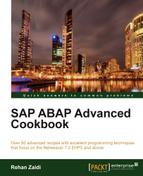Advanced Business Application Programming (ABAP) is SAP’s proprietary 4th Generation Language (4GL). SAP core is written almost entirely in ABAP. ABAP is a high level programming language used in SAP for development and other customization processes. This book covers advanced SAP programming applications with ABAP. It teaches you to enhance SAP applications by developing custom reports and interfaces with ABAP programming. This cookbook has quick and advanced real world recipes for programming ABAP.
It begins with the applications of ABAP objects and ALV tips and tricks. It then covers design patterns and dynamic programming in detail. You will also learn the usage of quality improvement tools such as transaction SAT, SQL Trace, and the code inspector. Simple transformations and its application in Excel downloading will also be discussed, as well as the newest topics surrounding Adobe Interactive Forms and the consumption and creation of Web services. The book comes to an end by covering advanced usage of Web Dynpro for ABAP and the latest advancement in Floorplan Manager.
Chapter 1, ABAP Objects, introduces useful recipes related to the object-oriented programming. This will include useful design patterns, the shared memory, and the persistent object concept.
Chapter 2, Dynamic Programming, covers facets of dynamic programming as applied in ABAP, such as Dynamic Open SQL and usage of field symbols and references.
Chapter 3, ALV Tricks, shows how you can get the most out of ALV programs. Starting with a simple ALV program, we will add code in recipes to fulfill a variety of user requirements.
Chapter 4, Regular Expressions, guides you on how you can embed regex programming in your ABAP programs and solve complicated problems in the least possible time and with minimal code.
Chapter 5, Optimizing Programs, shows the newer feature of secondary indexes and the transaction SAT (runtime analyzer) along with valuable program optimization tips.
Chapter 6, Doing More with Selection Screens, discusses recipes based on less frequently applied functionality within ABAP programs’ selection screens, such as the addition of tabstrips and placement of buttons on toolbar. In addition, we will see how to take folder and file names as input, followed by a recipe for writing code in search help exits.
Chapter 7, Smart Forms – Tips and Tricks, introduces various recipes based on Smart forms and fulfilling user’s form printing requirements in the least possible time.
Chapter 8, Working with SQL Trace, provides lesser-known tricks related to the SQL Trace tool. This will include the performance optimization usage of the SQL trace tool as well as the use of finding data source of screen fields.
Chapter 9, Code Inspector, shows how to check the quality of custom programs using standard checks, along with the procedure for creating your own checks.
Chapter 10, Simple Transformations, discusses in detail the Simple Transformation language and the representation of data variables in it, the application for Excel download format will also be shown.
Chapter 11, Sending E-mail Using BCS Classes, covers the classes of the Business Communication Service (BCS) for e-mail generation. This chapter will cover everything from simple e-mails for SAP users to Internet e-mail addresses, and also the procedure for adding attachments of various formats.
Chapter 12, Creating and Consuming Web Services, covers the step-by-step procedure for the creation of Web services based on an ABAP function module using the Inside-Out approach. The steps required to create a consumer of the Web service will also be shown.
Chapter 13, SAP Interactive Forms by Adobe, shows how to create both print and interactive forms using the SAP Interactive forms technology. A number of scenarios such as Offline form processing will also be covered.
Chapter 14, Web Dynpro for ABAP, shows how to create simple and advanced Web Dynpro for ABAP (WD4A) applications. The advanced topics related to the Web Dynpro components will also be covered.
Chapter 15, Floorplan Manager, covers newer features of the Floorplan Manager design used for creating Web Dynpro applications quickly. Both the configuration and coding for useful Floorplans will also be covered.
